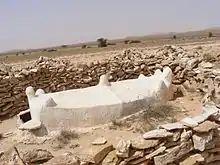Dobira
Dobira (Arabic: دُومبِرَ بِنت دَغَالَ), also known as Dobira or Dombiro was a Somali historical figure.
| Dombira دومبرة | |
|---|---|
| Mother of all Darod clans | |
 | |
| Religion | Islam |
Biography
Dobira was the daughter of Dagale (Dikalla), the Dir clan chief.[1][2] While other historical works mention that Dombira was the daughter of Hawiye.[3] With that Darod established link with the main Samaale Somali's. Samaale is said to have been an Arab migrant from Yemen arriving in the 9th century. [4][5][6] [7]
During the 10th or 11th century CE,[8] Dobira married Sheikh Abdirahman bin Isma'il al-Jabarti (Darod), a son of the Sufi Sheikh Isma'il al-Jabarti of the Qadiriyyah order, who had settled in Somaliland just across the Red Sea. The union is said to have given rise to the Darod clan family.[2]
Dobira is buried just outside the ancient town of Haylaan in the Sanaag region of Somaliland, where Sheikh Darod's tomb is located.
Notes
- Mandelli, Alfonso. Nuove indagini su Antonio Stradivari: 23 incisioni e 4 fac-simili. U. Hoepli, 1903.
- Somaliland Society (1954). The Somaliland Journal, Volume 1, Issues 1-3. The Society. p. 85.
- Hunt, John Anthony (1951). A general survey of the Somaliland Protectorate 1944-1950: final report on 'An economic survey and reconnaissance of the British Somaliland Protectorate 1944-1950,' Colonial Development and Welfare Scheme, Part 484. To be purchased from the Chief Secretary. p. 151. OCLC 3011788.
Dir, the father-in-law of Darod, is said to be the uncle of Esa Madoba and brother of Hawiya Irrir, who founded the Esa tribe of Zeila and the Hawiya of Somalia respectively. Ram Nag, the great-grandfather of Dir, and Samarone the patriarch of the Gadabursi, are of unknown origin, but probably Arabians who landed at Zeila.
- Burton, Sir Richard Francis; Burton, Lady Isabel. The Works of Captain Sir Richard Francis Burton: First footsteps in East Africa. Tylston & Edwards. p. 74.
where he married a daughter of the Hawiyah tribe
- Burton, Richard Francis (1856-01-01). First Footsteps in East Africa. Longman, Brown, Green & Longmans. p. 104.
where he married a daughter of the Hawiyah tribe
- Somaliland Society (1954). The Somaliland Journal, Volume 1, Issues 1-3. The Society. p. 85.
- Lewis, A pastoral democracy, pp. 11–13.
- I.M. Lewis, A Modern History of the Somali, fourth edition (Oxford: James Currey, 2002), p. 22
